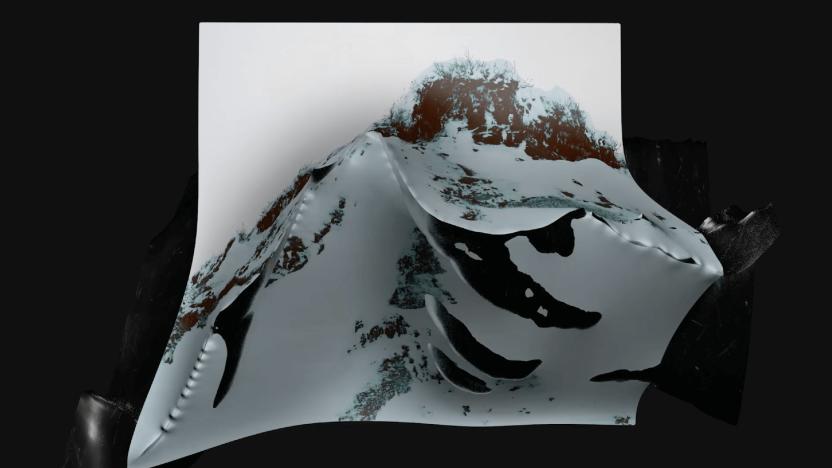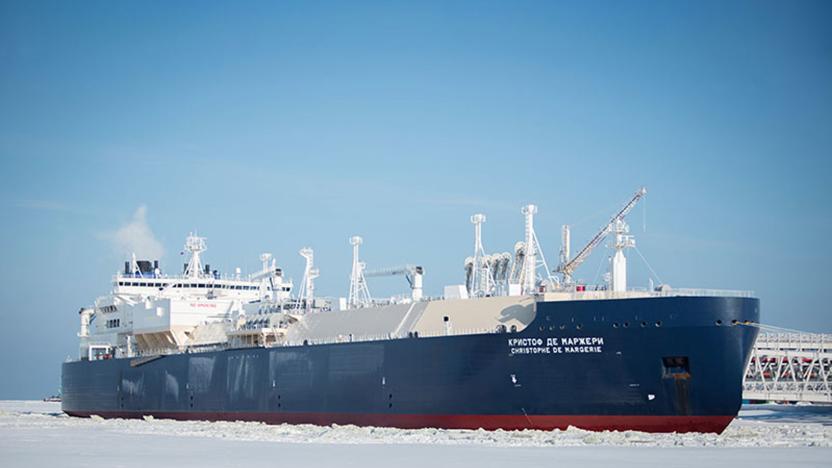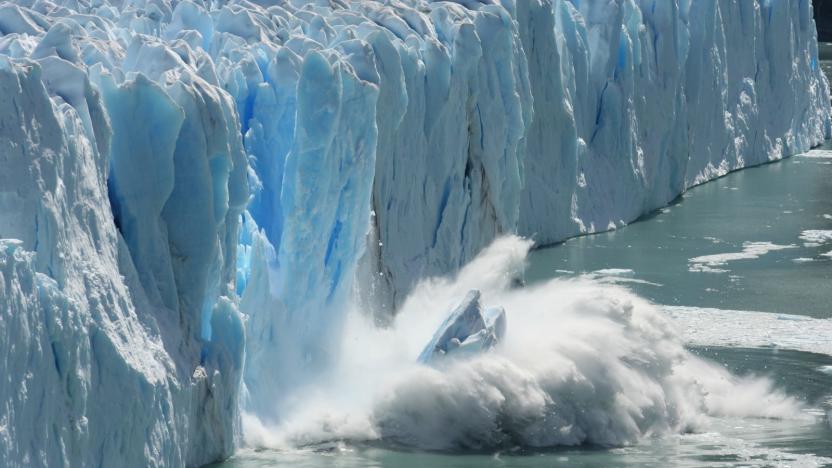arctic
Latest

Arctic communities are living in a future nobody wants
Of all the many tangible climate change impacts, none may be bigger than coastal erosion and permafrost slump.

Scientists have even found microplastics in the Arctic
Microplastics are polluting tap water, the deep sea and now even remote corners of the Arctic. Scientists found concentrations of plastic in ice floes from the Fram Strait, the passage that connects the Arctic Ocean to the rest of the world's oceans. Their findings, published today in Science Advances, offer further evidence that increased plastic production is impacting the environment in new, unforeseen ways.

Tanker's speedy Arctic crossing is bad news for the planet
Normally, smashing a transportation record is something to celebrate. This time, however, it's not necessarily worth cheering. Sovcomflot's liquefied natural gas (LNG) tanker Christophe de Margerie has become the first merchant ship to cross the Northern Sea Route without an icebreaker clearing its path. The vessel, which can plow through ice up to 6.9 feet thick all by itself, completed the icy part of a trip from Norway to South Korea in a record-setting 6.5 days by keeping up speeds (an average of 14 knots) that would have been impractical with the usual escort. That's despite ice as thick as 3.9 feet. So what's so bad? Unfortunately, it's as much an indication of the effect of global warming as it is technological progress.

Rise in Arctic Ocean acid pinned on climate change
Climate change isn't just manifesting in polar regions through ice cracks. Researchers have learned that the Arctic Ocean saw a rapid rise in acid levels between 1994 and 2010, most likely from airborne carbon dioxide (aka a greenhouse dissolving into the water. While this process is happening in many places around Earth, the Arctic increases are serious enough that they may pose a threat to polar bears, seals and other animals that depend on the ocean.

Arctic seed vault grows as defense against food crisis
In light of President Donald Trump's rise to power, some people are seriously worried about the planet's health. Count The Bulletin of the Atomic Scientists among that group, since they recently pushed the Doomsday Clock to two and half minutes to midnight. Even if they think humanity is closer to extinction than it was just a couple months ago, we're now better prepared to respond to a food crisis.

Prepare for even more volatile weather in 2017
Ice isn't just great for keeping your drinks cool at parties, it also helps keep our planet cool by reflecting some of the sun's heat away. But thanks to our glacially slow progress in addressing climate change, there's going to be a lot less ice in the Arctic next year. Scientists are observing record high temperatures in the Arctic circle that's likely to lead to record low levels of ice coverage in 2017. Long story short, we're currently melting the wall that's helped stop the seas boiling for all of these years.

Hydroponic gardens could end Arctic food shortages
You don't have a wide variety of food choices if you live in remote parts of the Arctic. Some consumables can take so long to arrive that they're already past their "best before" dates, and that's assuming they arrive in the first place -- shortages are considerably more common. However, Alaskan companies Native Kikiktagruk Inupiat Corp and Vertical Harvest Hydroponics could make fresh greens a mainstay even in more inaccessible regions. They've developed indoor hydroponic gardens that grow vegetables like kale and lettuce in shipping containers filled with LED lights. As you don't need soil or a warm climate, you can provide tasty veggies just about anywhere you have reliable power.

Scientists finally made a half-way decent map of Alaska
To protect the Arctic from climate change, scientists require a detailed map which they can slowly update and reference over time. Such a resource has, until now, been difficult to produce because traditional capture methods -- low-flying aircraft, for instance -- are expensive or ill-equipped to deal with the region's harsh weather patterns. That's now changed, however, thanks to a project spearheaded by the National Geospatial-Intelligence Agency (NGA) and the National Science Foundation. Following a directive from President Obama, the group has captured Alaska with a new level of clarity, using commercial satellites owned by Digital Globe.

Russia debuts the largest ever nuclear icebreaker
Russian cargo ships understandably have to wade through a lot of ice, and the country plans to deal with that frozen water in style. It recently floated out the Arktika, which it bills as the "largest and most powerful" nuclear-powered icebreaker in the world. At nearly 569 feet long and 112 feet wide, the twin-reactor boat can carve a gigantic path through some of the sea's toughest obstacles -- it can cut through ice roughly 10 feet thick. It can haul about 36,000 short tons, and there's a helicopter to scout for any upcoming floes.

Arctic drone is tough enough to monitor icy waters
Sure, there are already drones out there that can take a bruising, but can they survive the brutally cold Arctic Ocean? Laval University's Argo drone can. The newly developed robotic submersible can reach depths of 6,560 feet as it collects data about organisms in bitterly cold waters, and its laser scanning system helps it avoid ice whenever it returns to the surface to transmit data. Not that Argo needs to poke its head above the water very often -- it can run for up to four years at a time. The machine is still in testing at the moment. If everything goes well, however, the drone will be tracking the biological effects of climate change within a matter of months. [Image credits: AP Photo/John McConnico (top), Claudie Marec/Laval University (bottom)]

University of Victoria's Mano underwater robot to prowl Arctic waters for legendary ships
Canadians well-versed in their history are very aware of Sir John Franklin's ill-fated 1845 expedition to find the Northwest Passage: a British voyage that set out to establish a sailing route through the Arctic and ended with the untimely, mysterious deaths of its two ship crews. No human ever found the abandoned ships, which makes it all the more fitting that the next best shot at discovery might come through a just-launched autonomous underwater vehicle from the University of Victoria and Bluefin Robotics. Meet the Mano, a new sonar-toting robot that can produce detailed undersea maps all by its lonesome while keeping a steady altitude above the ocean floor. It can only operate for 12 hours at a time, which will keep humans in the area, but its ability to run untethered below storms and cold Arctic winds should dramatically expand the territory that researchers can cover during their share of a larger five- to six-week journey. There's no guarantee that the Mano will hit the jackpot, or find something recognizable even if it does. Still, any mapping should improve navigation for modern boats -- and hopefully prevent others from sharing Sir Franklin's fate.

New undersea cables planned for arctic passageways, frozen gamers dream of lower pings
Hot on the heels of our own reporting of cables in the South Pacific (or the lack thereof), in flies a report that at least two new undersea cables are being planned for the arctic. According to New Scientist, a pair of lengthy fiber optic wires will be laid through the Northwest Passage above North America, connecting Japan to the United Kingdom. Moreover, a third cable is planned along the Russian coastline, with the longest of these links to purportedly become "the world's longest single stretch of optical fiber." A number of outfits are on the list to help out, and when complete, the latency between Tokyo and London should be reduced between 168ms and 230ms. The cost for such luxury? An estimated $600 million to $1.5 billion for each line. In other words, totally worth it.

Delkin's CF cards handle all weathers, so quit yo' jibber jabber
Delkin sneers at wimps who sit around all day debating whether it's worse to be too hot or too cold. Its new 32GB and 64GB rugged CompactFlash cards relish both extremes, with a claimed operating temperature range of -40 to +85 degrees Celsius. They achieve this by eschewing the cheaper multi-level cell design of namby-pamby mainstream cards in favor of single-level cells that last for up to two million cycles and max out at 105MB/s reads and 95MB/s writes. We wouldn't stick anything else in our SnoMote. Full details in the PR after the break.

Exclusive screenshots of EverQuest II: Destiny of Velious revealed
If you mention the word Velious to most fans of the original EverQuest, you'll instantly see their eyes light up. The original Velious expansion was a revolution for EverQuest back in 2000, so it's no surprise that EverQuest II fans are getting excited about the upcoming Destiny of Velious expansion. Sony Online Entertainment has big shoes to fill with this update, which is due to launch later this month on February 22nd. Information on the Velious content has been sparse recently, with only a few lore reveals and a trailer released in the past few months. Today, SOE has released several screenshots of new zones in the expansion, exclusive to Massively. To put the new EQ2 screenshots into their proper contexts, SOE has provided the following lore: "This glacial tundra bears the scars of centuries of conflict and strife. Here, adventurers can find the haunted remnants of the series of battles known as the Ring War, which was fought between the dwarven race known as the Coldain, and their ancient enemy, the Kromrif. On the southern tip lies the remains of a crumbling fortress, now occupied by the savage snow orcs known as the Ry'Gorr. To the west lies the Storm Gorge, a massive valley carved from the land during the continent-cracking event known as the Upheaval. There, the noble coldain stand against the might of the fearsome and militaristic legion known as the Order of Rime, and fight to protect their beloved city of Thurgadin." %Gallery-116188%

College students help NASA by crashing satellite into the Arctic
Our idea of a great evening in college was listening to some Operation Ivy and drinking a few brews before heading home to secretly pore over A Literature of Their Own. Other college kids, however, have more on their plates than that, such as those who currently work at LASP -- the Laboratory for Atmospheric and Space Physics. LASP is partially staffed by undergraduates at Colorado University, providing a low-cost alternative to more experienced labor, while giving students the kind of hands-on experience not normally available to them. One recent task, for instance, involved the crashing of ICESat, a NASA decommissioned satellite, into the Arctic. Most of it burned up in the atmosphere, while some smaller parts made their way to the Barents Sea. The mission was considered successful and, as for the students who carried it out? Well, let's just say that their nerd credentials are now rock solid.

SnoMote robots could autonomously explore Antarctic
We've seen a couple robotic efforts to explore the Arctic and the Antarctic, but they've all been remotely-operated -- unlike the SnoMote, a new bot being developed at the Georgia Tech that can navigate itself around ice and snow. Packs of the mini-snowmobile-based SnoMotes can negotiate with each other and "bid" on locations to investigate, and navigate by classifying microscopic fissures in the icy terrain. The bots haven't made it to the Antarctic yet, but they're apparently handling simulations quite well, and the plan is for teams of 40 to 50 of the $10,000 machines to wander the ice collecting data points for climate change models. Sure sure -- and the next thing you know, the Antarctic is the flashpoint of the revolution. Good plan, guys.

A distinct lack of murlocs
Micromachine drops a question that I can't believe we forgot to ask at BlizzCon: Will there be murlocs in the next expansion? There definitely was a distinct lack of murlocs in Outland-- but for the few packs in Serpentshrine Cavern and the Dancing Murloc quest, we didn't hear that throaty gurgle almost at all. And as much as I hate it, I... kind of miss it.It's not like they wouldn't fit, either-- Northrend has a coast that we'll be visiting, and while it's a little colder up there, Murlocs are pretty adaptable creatures. Plus, the Tuskarr are a race of fishermen-- errr, fisherwalruses-- and they'd probably love to have the Murlocs around, for dinner if for northing else. I'm not sure exactly what an Arctic Murloc would look like, but I'd definitely like to find out.Then again, as someone mentions in the thread, we'll probably get our fill of Murlocs whenever Blizzard gets around to making the Maelstrom expansion and tells us what all the Murlocs are doing on land in the first place. But until then, while it's OK to leave Murlocs out of Outlands (because how are they going to get there in the first place), it's unacceptable to completely leave Murlocs off the northern continent of Azeroth. Bring on the gurgle!

NASA funded robots to search for life under Arctic ice
In a mission that is apparently similar to searching for life under the ice of Jupiter's moon Europa (sans the space travel part), three robots are set to start a mission to explore the underwater hot springs under the ice of the Arctic: because someone else did the Antarctic last year. On a 40 day expedition in July, researchers from Cape Cod hope to use three new robotic vehicles -- two that can operate without cables under ice -- to find life that resides in the hot streams along the techtonic boundary between Eurasia and North America. Although the robots can descend over 3 miles under the water working just meters from the bottom to photograph objects and collect samples, the task of the NASA-funded $450,000 Puma and Jaguar robots will be hindered by the rough terrain and their inability to surface through the ice. Sounds like NASA's got quite a while to go until it can submarine around Europa -- they probably won't be able to surface there at all.

How would your DS fare ... in a volcano?
That's one of the many tough questions Robert Falcon asks over at modojo.com. He decided to analyze the DS and PSP's ability to survive various natural disasters, including floods, earthquakes, and blizzards. Keep in mind that if your DS Lite somehow manages to find its way into a pit of boiling lava, you need to take pictures so we can post them. Seriously, that stuff is blogging gold.On a slightly more serious tack, has anyone had a DS or DS Lite miraculously survive when it had no right doing so? Let us know![Thanks, Justin!]








